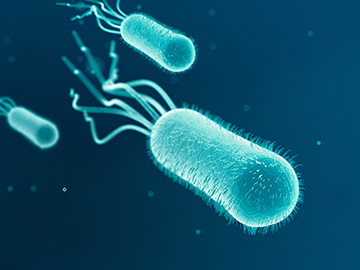
A dual-light technique has been shown to deactivate a variant of E. coli that is resistant to conventional antibiotics. [Image: luismmolina / Getty Images]
Researchers in New Zealand have shown that a strain of Escherichia coli that is resistant to antibiotics can be deactivated by irradiating it with two different wavelengths of light at the same time (J. Appl. Microbiol., doi: 10.1093/jambio/lxad124). The dual-wavelength technique delivers the same antimicrobial power as the ultraviolet lamps that are commonly used to disinfect water, air and surfaces, but in this case the two frequencies pose much less danger to human health.
Safer disinfection
The E. coli bacterium tested by the scientists, known as ESBL-Ec, is one of a growing number of so-called superbugs that cannot be treated with conventional antibiotics. Reducing the risk of infection requires safe and effective ways to sanitize common sources of contamination—such as hospitals, water treatment plants and facilities for food preparation—without causing more resistant variants to emerge.
The dual-wavelength regimen combines blue light-emitting diodes operating at 405 nm with ultraviolet light at 222 nm, which lies in the far-UVC part of the spectrum. In contrast, traditional UV lamps produce radiation at 254 nm, which is known to damage human tissue—particularly the skin and the eyes—after repeated or prolonged exposure.
Effective yet resistible
The researchers found that combining the two wavelengths improves their overall effectiveness by triggering different mechanisms that disrupt the activity of the microorganisms.
The researchers found that combining the two wavelengths improves their overall effectiveness by triggering different mechanisms that disrupt the activity of the microorganisms. The same method was also shown to deactivate another variant of E. coli that does respond to antibiotic treatment, suggesting that the dual-light technique could be used to combat a broad range of harmful microbes. “There is great potential for these two light wavelengths to be used together in many applications where safety to the end user is of most importance,” comments Amanda Gardner, AgResearch Ltd., who contributed to the work.
However, the researchers also found that ESBL-Ec can start to tolerate light after repeated irradiation at sublethal levels, an effect that was not observed for the variant that is sensitive to antibiotics. Gardner says further work is now needed to understand whether the light tolerance exhibited by ESBL-Ec might be caused by a genetic change or whether some other mechanism is at play. “It will also be important to investigate the development of light tolerance in other antimicrobial-resistant bacteria and to determine the minimum dose of far-UVC light that can create light tolerance,” adds Gardner.
